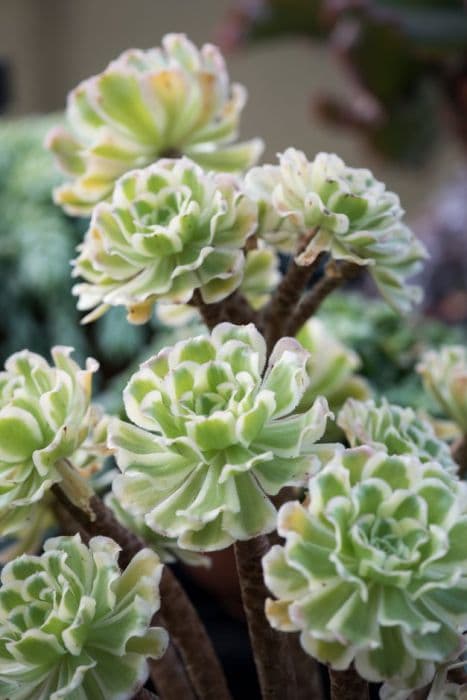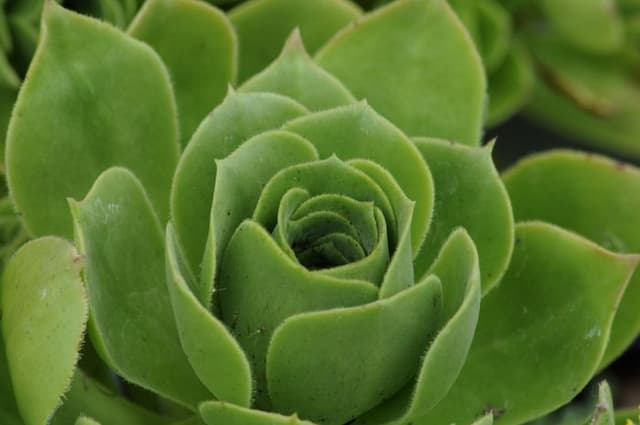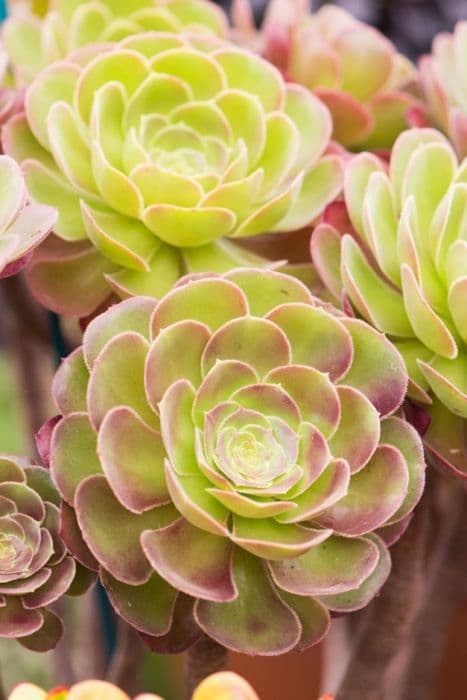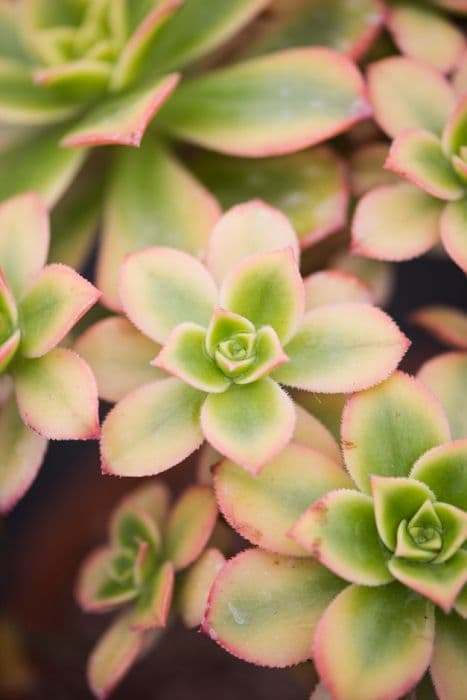Cornish Aeonium Aeonium 'Cornish Tribute'

ABOUT
The Aeonium 'Cornish Tribute' is a striking succulent, known for its rosette-forming foliage and captivating appearance. Each rosette comprises tightly packed leaves that emerge in an alluring spiral pattern. The leaves themselves possess a remarkable color palette, blending shades of deep green at the base with hints of burgundy or purple near the tips, giving the impression of a gradient or two-toned effect. They are thick, fleshy and have a glossy, slightly waxy texture which is characteristic of many succulents that store water to endure dry conditions. As the plant matures, the rosettes create an almost sculptural display, overlapping and spreading out from the central stem. The plant occasionally produces flower spikes, where clusters of small, star-shaped flowers may bloom in a complementary hue to the dramatic foliage below. Commonly, these flowers are yellow or cream in color, adding to the decorative appeal of the Aeonium 'Cornish Tribute'. Overall, the plant's rich color contrast and growth pattern make it a popular choice for ornamental purposes in gardening and landscaping. It is admired for its structural beauty and can serve as a focal point in container gardens, rockeries, or as part of a succulent tapestry when combined with other drought-tolerant plants.
About this plant
 Names
NamesSynonyms
Cornish Tribute Aeonium, Cornish Tribute Stonecrop
Common names
Aeonium 'Cornish Tribute'
 Toxicity
ToxicityTo humans
Aeonium 'Cornish Tribute', commonly known as Aeonium, is generally considered non-toxic to humans. Therefore, ingesting it is not expected to cause poisoning. However, as with any non-edible plant, it is advisable to exercise caution and keep plants out of the reach of children, who might be tempted to eat them out of curiosity.
To pets
Aeonium 'Cornish Tribute', commonly referred to as Aeonium, is not known to be toxic to pets. If a pet ingests part of this plant, it is unlikely to lead to poisoning. Nonetheless, it's always a good practice to monitor pets around plants and discourage them from chewing on any non-food items to prevent the potential for digestive upset.
 Characteristics
CharacteristicsLife cycle
Perennials
Foliage type
Evergreen
Color of leaves
Variegated
Flower color
Yellow
Height
2 feet (0.61 meters)
Spread
2 feet (0.61 meters)
Plant type
Succulent
Hardiness zones
9
Native area
Canary Islands
Benefits
 General Benefits
General Benefits- Easy to Grow: Aeonium 'Cornish Tribute' is a low-maintenance plant that is easy to care for, making it ideal for beginner gardeners.
- Drought Tolerant: It has succulent leaves that store water, allowing it to survive in dry conditions with minimal watering.
- Decorative Appearance: The plant features attractive rosettes of leaves that can add aesthetic appeal to gardens, patios, and indoor spaces.
- Compact Size: It remains relatively small, which makes it suitable for growing in containers or small garden spaces.
- Unique Texture: The fleshy leaves provide a unique textural element to plant arrangements and landscapes.
- Versatility: It can be used in rock gardens, as ground cover, in containers, or as part of succulent arrangements.
- Seasonal Interest: In cooler climates or seasons, the leaves can take on a more intense color, adding seasonal interest to the garden.
- Propagation: It can be easily propagated from cuttings, which allows gardeners to multiply their plants and share with others.
 Medical Properties
Medical PropertiesThis plant is not used for medical purposes.
 Air-purifying Qualities
Air-purifying QualitiesThis plant is not specifically known for air purifying qualities.
 Other Uses
Other Uses- Crafting Material: The fleshy leaves of Aeonium can be used in crafting, such as making botanical prints on paper or fabric.
- Photography Subject: Given their unique rosette shapes and colors, Aeoniums are often used as subjects for botanical photography.
- Educational Tool: Aeoniums can be used in educational settings to teach about succulent care, propagation, and water conservation practices.
- Art Inspiration: Artists may use Aeoniums as inspiration due to their geometric patterns and vibrant colors for paintings, drawings, or sculptures.
- Special Events Decoration: These plants can be used as living decorations for events like weddings or parties, especially in succulent bouquets or centerpieces.
- Feng Shui: Some people believe Aeoniums can be used to create positive energy when placed in certain areas of the home according to Feng Shui principles.
- Color Dye: The pigments in some Aeoniums may be used for natural dyeing processes for fabrics or other materials.
- Living Mulch: In garden beds, Aeoniums can serve as living mulch by covering the soil and helping retain moisture.
- Seasonal Displays: Aeonium ‘Cornish Tribute’ changes color with the seasons, which can be featured in seasonal decorative displays.
- Container Gardens: They are excellent for use in container gardens, adding structure and interest due to their height and shape.
Interesting Facts
 Feng Shui
Feng ShuiThe Aeonium is not used in Feng Shui practice.
 Zodiac Sign Compitability
Zodiac Sign CompitabilityThe Aeonium is not used in astrology practice.
 Plant Symbolism
Plant Symbolism- Resilience: Aeonium plants, due to their succulent nature, are known for their ability to withstand drought and poor soil conditions. This makes them symbols of enduring tough environments and bouncing back from adversity.
- Adaptability: The Aeonium 'Cornish Tribute', like other Aeoniums, can adapt to different lighting conditions, symbolizing the ability to thrive in various situations and adapt to change.
- Eternal Life: The evergreen nature of Aeoniums, coupled with their rosette shape that can resemble a lotus, often symbolizes eternal life or immortality.
- Beauty and Uniqueness: With its attractive rosette pattern and dark foliage, Aeonium 'Cornish Tribute' is often associated with beauty and the uniqueness of every individual’s life journey.
 Water
WaterAeoniums, including the 'Cornish Tribute', prefer moderate watering. Allow the soil to dry out between waterings, typically watering every 7 to 10 days, depending on climate conditions. Use about 8 to 16 ounces of water per plant when you water, ensuring it reaches the roots without overwhelming the plant. Avoid letting the plant sit in water as this can lead to root rot. During dormant seasons, such as winter, reduce watering frequency.
 Light
LightAeonium 'Cornish Tribute' thrives best in full to partial sun. It should be placed in a location where it can receive at least six hours of sunlight daily. However, provide some shade during the hottest part of the day to prevent sunburn, especially in very hot climates.
 Temperature
TemperatureThe 'Cornish Tribute' Aeonium does best in temperatures ranging from 40 to 100 degrees Fahrenheit. It can tolerate mild frosts and cold down to approximately 40 degrees Fahrenheit but should be protected from severe frost. The optimal growing temperature for this aeonium is between 65 and 75 degrees Fahrenheit.
 Pruning
PruningPruning Aeonium 'Cornish Tribute' is generally done to remove spent flowers or to shape the plant. Prune in the spring by cutting back the flowering stems to improve the plant's appearance and encourage bushier growth. Pruning once a year is typically sufficient for these plants.
 Cleaning
CleaningAs needed
 Soil
SoilAeonium 'Cornish Tribute', commonly known as Aeonium, thrives best in a well-draining soil mix composed of equal parts perlite or pumice, coarse sand, and potting soil. The ideal soil pH for Aeoniums is slightly acidic to neutral, ranging from 6.0 to 7.5. Amending the soil with organic matter can help with fertility but ensure it does not retain excessive moisture.
 Repotting
RepottingAeoniums, including 'Cornish Tribute', should be repotted every two to three years to provide fresh soil and room for growth. Best done in the spring, repotting should involve examining the roots for health and trimming if necessary before placing into a slightly larger pot.
 Humidity & Misting
Humidity & MistingAeonium 'Cornish Tribute' prefers a dry to average humidity level, typical of its native environment. Aim for humidity levels around 40-50% for optimal growth, avoiding excessively humid conditions which can promote rot.
 Suitable locations
Suitable locationsIndoor
Grow Aeoniums in bright light, minimal water, well-draining soil.
Outdoor
Place Aeoniums in partial sun, protect from frost, well-draining soil.
Hardiness zone
9-11 USDA
 Life cycle
Life cycleAeonium 'Cornish Tribute', commonly known as Aeonium, begins its life cycle when seeds germinate in well-draining soil with adequate warmth and moisture. The seedlings then develop rosettes of succulent leaves as they mature into juvenile plants. As an adult, the Aeonium 'Cornish Tribute' forms a branching stem with clusters of rosettes at each tip, typically showing off its full foliage during the cooler months and becoming dormant in extreme heat. During its flowering stage, which occurs typically in the spring or early summer, the plant produces pyramidal inflorescences with yellow to white flowers atop a tall stalk, after which the flowering rosette often dies. The plant can propagate vegetatively by offsets, which are small rosettes that form at the base of the parent plant and can be separated to grow new individuals. The life cycle of the Aeonium 'Cornish Tribute' is perennial, repeating its growth, flowering, and propagation phases for several years under favorable conditions.
 Propogation
PropogationPropogation time
Spring-Early Summer
The Aeonium 'Cornish Tribute', also known simply as Aeonium, is typically propagated through cuttings. The best time to propagate Aeoniums is during the plant's active growth period which is generally in the spring or early summer. To propagate by cuttings, a healthy leaf or a rosette with a bit of stem should be carefully removed. Let the cut end callous over for a few days to prevent rotting. After that, plant the cutting in well-draining soil, ideally a cactus or succulent mix. The cutting should be placed just deep enough to stand upright. Watering should be minimal until roots develop, which usually takes a few weeks. Once the plant is rooted and showing signs of growth, watering can be increased gradually.









